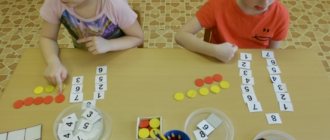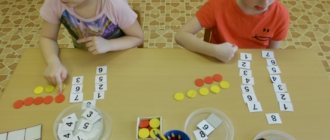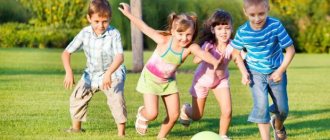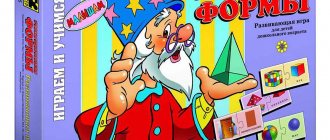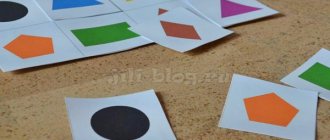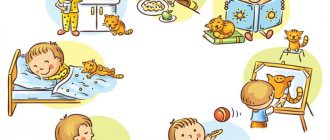Mathematics for a child who is 4 years old is a very broad topic that is difficult to fit into one article. Nevertheless, I took it on. If you liked what I wrote and found it useful, I will be grateful for any comment and for all reposts 
While in addition to home, my daughter also studies English at the center, then mathematics is a completely home (and street) subject for us. When teaching a child, it doesn't matter what grade you got in math. However, it is also true that even if you had a solid “A” in this discipline at school, there are points that need to be taken into account in classes with kids. I gleaned the following thoughts from Zhenya Katz’s book “Leaping Mathematics” (links to the book: on Ozone, in the Labyrinth)
If you are ready to study, but something keeps stopping you, you can’t get it together or you’re not sure if you can handle it, then you might find this article useful on how to start regular lessons with your child.
For comprehensive development, do not forget to read with your child - read often, a lot, in a variety of ways. Here is a description of several books that my daughter liked at just over 4 years old.
What should a 4-5 year old child know in mathematics?
A four to five year old child should:
- Know basic geometric shapes: square, circle, rectangle, oval, triangle.
- Be able to count to ten and recognize numbers from zero to nine by sight.
- Be able to arrange numbers from one to five both in order and in reverse order.
- Find your bearings in the location of objects: where is right, left, top, bottom, front, back.
- Know and distinguish between the time of day and the seasons.
- Learn to write numbers correctly.
- Be able to compare: what is more, what is less, and what is equal.
- Know the meaning of the words: high - low, wide - narrow.
Child practicing in the garden
Important! A child, and especially a preschooler, will perceive the learning process better if it is turned into a children's game. During play, the child is more active, more attentive to the material and more fun.
“Fun mathematics” work program in mathematics (middle group)
WORKING PROGRAM OF THE CIRCLE
"Fun Math"
(for children 4 – 5 years old)
Four-year-old children are actively mastering counting, using numbers, performing basic calculations visually and orally, mastering the simplest temporal and spatial relationships, and transforming objects of various shapes and sizes. The child, without realizing it, practically gets involved in simple mathematical activities, while mastering properties, relationships, connections and dependencies at the subject and numerical levels. The scope of ideas offered by this program should be considered as the basis of cognitive development. Cognitive and speech skills, indicated after the content, constitute, as it were, the technology of the cognition process, a minimum of skills, without the development of which further knowledge of the world and the development of the child will be difficult. The child’s activity, aimed at cognition, is realized in meaningful independent play and practical activities, in educational and educational games organized by the teacher. It is impossible to do without didactic aids. They help the child isolate the object being analyzed, see it in all its diversity of properties, establish connections and dependencies, and determine relationships of similarity and difference. By playing and studying with children, the teacher helps them develop skills and abilities:
- operate with properties, relationships of objects, numbers; identify the simplest changes and dependencies by their shape and size;
- compare, generalize groups of objects, correlate, isolate patterns of alternation and succession, operate in terms of ideas, strive for creativity;
- show initiative in activities, independence in clarifying or setting goals, in the course of reasoning, in carrying out and achieving results;
- talk about the action being performed or completed, form a dialogue with adults and peers about the content of the game (practical) action.
The teacher promotes the development of the following properties in children of this age. Children should be able to identify:
- size of objects: length (long, short); by height (high, low); in width (wide, narrow); by thickness (thick, thin); by weight (heavy, light); by depth (deep, shallow); by volume (large, small) - geometric shapes and bodies: circle, square, triangle, oval, rectangle; ball, cube, cylinder. Structural elements of geometric shapes: side, angle, their number. Shape of objects: round, triangular, square, quadrangular;
- logical connections between groups of objects by size, shape (low but thick; squares have more sides than triangles); finding common and different in groups of figures of round, square, triangular shapes;
- connections between changes (changes) in the basis of the grouping and the number of resulting groups and items in them. Grouping objects by shape, children identify 3 groups (round, triangular, square) with a certain number of elements in each of them. And in size - 2 groups, the number of elements in each of which has increased;
- generalize geometric shapes, objects by shape, size: classifying objects and figures with 4 sides and 4 corners as quadrangular objects, of a certain gravity - as heavy (“These stones are all heavy”), etc.
Relationship. Representation.
Children should be able to identify:
- relations between groups of objects: by quantity (equality and inequality expressed in numbers); by size (length, width, thickness, weight), etc. Consecutive increase (decrease) of 3-5 items (wide; narrower; even narrower; the narrowest ribbon);
- spatial relationships in paired directions from oneself, from other objects, in movement in the indicated direction; temporal (in the sequence of parts of the day, present, past and future tense: yesterday, today and tomorrow);
- generalize 3-5 objects, sounds, movements by properties: size, quantity, shape, etc. (“The same quantity, also 4 each; all red and tall columns 4 each”);
- generalize all parts of the day into one concept - “day”. Numbers and numbers.
Representation. Children should be able to:
- indicate quantities of up to 5-10 items by number and figure; know numbers from 0 to 10; quantitative and ordinal assignment of numbers;
- determine the connections between number, number and quantity: the more objects, the larger the number they are designated; count homogeneous and dissimilar objects in different locations.
To implement continuity in the formation of basic mathematical concepts in kindergarten. This goal involves not only preparing children for successful learning, but also comprehensive development.
- familiarize children with geometric shapes and shapes of objects, size
- development of quantitative concepts, the ability to distinguish between quantitative and ordinal counting, to establish equality and inequality of two groups of objects;
- development of the ability to distinguish and name geometric shapes, silhouettes, objects and others in the modeling process;
- teach solving logical problems;
- form basic mental operations (comparison, generalization, classification, analogy) thinking, imagination.
- Expand your mathematical vocabulary, improve coherent speech, and the ability to argue your statements;
- give ideas about numbers and numbers from 1 to 10
In the process of forming elementary mathematical concepts, a variety of teaching methods are used: practical, visual, verbal, game. When choosing methods and techniques of work, the following are taken into account: the goal, objectives, age and individual characteristics of the children.
The activity method corresponds to the level of development of visual-effective and visual-figurative thinking.
Thus, the characteristic features of the practical method in the formation of elementary mathematical concepts are considered to be:
- Performing a variety of practical actions;
- Wide use of didactic material;
- Develop numeracy, measurement and reasoning skills.
- Wide use of elementary mathematical concepts in practice, everyday life, games and other activities. The practical method involves organizing exercises, using both collective and individual forms of execution.
When forming elementary mathematical concepts, great importance is attached to games as a teaching method. Wide
A variety of didactic games are used (objective, board-printed, verbal). A special role is given to gaming and entertaining tasks.
| Lesson topic | Program content | ||
| September | |||
| 1. | "Comparison of objects." | Learn to compare two groups of objects by superimposing and applying, find identical ones, be able to navigate space. Develop attention and thinking. Cultivate diligence. | D/i “Multi-colored balls” |
| 2. | "Get some berries." | Develop the idea of equality and inequality of groups of objects by superimposing one object on another. | |
| 3. | "Numbers 1, 2." | Learn to count to two, use numbers 1 and 2; compare two groups of objects, establishing ratios: more - less, equally; find and name objects round and square shape in a given space. | D/i “Who will bring more” |
| 4. | "Come to the meadow." | Teach children to compare and distinguish objects by size. | D/i “Find the same one.” |
| 5. | "One, many." | Introduce the concepts of “one” and “many”. Develop fine motor skills and thinking. Cultivate perseverance. | |
| 6. | “One, two, three - look.” | Teach children to build an image of an object of a given size and use it in play activities. | |
| 7. | "Big small". | Introduce the concepts of “big” and “small”. Develop the ability to group objects according to a given characteristic. | D/i "Bunnies". |
| 8. | "Geometric Lotto" | Mastering the ability to identify different shapes. | |
| October | |||
| 1. | “Where is the right, where is the left.” | Learn to navigate in space: above, below, above, below; distinguish between left and right; practice counting within two, distinguish and name the numbers 1 and 2. Develop orientation in space, attention. Cultivate perseverance. | |
| 2. | “Who will roll the ribbon sooner?” | Develop an attitude towards size as a significant feature, pay attention to length. | |
| 3. | "Orientation in space." | Develop skills to navigate in space; form an idea of what each person has 2 and 1; learn to distinguish between parts of the day: morning - evening, day - night; learn to name square and round objects. Develop orientation in space, memory. Cultivate perseverance | D/i “Where is the right, where is the left.” |
| 4. | "Help the chickens." | Establishing correspondence between sets. | |
| 5. | "Number 3". | Introduce the formation of the number 3 and the corresponding figure; learn to name numbers from 1 to 3; count and arrange objects with the right hand from left to right; practice orientation in space. Develop thinking and attention. Bring up careful handling of handouts. | D/i “What has changed?” |
| 6. | "Get some berries." | Teach children to distinguish between equality and inequality of objects by placing one object under another | |
| 7. | Comparison by height. | Practice counting within 3; learn to compare objects by height, reflect the result of comparison in speech, learn to compose an object from 3 isosceles triangles; find objects of the same height in the environment. Develop logical thinking. Cultivate perseverance. | D/i “Higher-lower”. |
| 8. | “Whose tail is longer?” | Teach children to compare objects that are contrasting and of the same size in length and width. | |
| November | |||
| 1. | "Ball." | Introduce the ball in a playful way and reinforce orientation in space. Develop logical thinking. Bring up interest in peers. | D/i "Guess" |
| 2. | “Find the same amount.” | Teach children to compare two groups of objects and establish relationships between objects: “more”, “less”, “equally”. | |
| 3. | "Triangle". | Fix the names of geometric shapes; learn to find objects of the named shape; learn to make a house from 4 triangles made from a square; learn to compare objects by length and reflect the result of the comparison in speech. Develop logical thinking and imagination. Cultivate the desire to complete the work started. | D/i “Wonderful bag” |
| 4. | "Corners". | Teach children to name, recognize and distinguish geometric shapes, compare, find similarities and differences. | D/i “What comes in this shape?” |
| 5. | "Cube". | Introduce the cube in a playful way and teach how to examine it. Develop sense of touch and attention. Cultivate an interest in the environment. | |
| 6. | "Dressy little animals." | Develop an attitude towards size as a significant feature, pay attention to length, consolidate the concept of “long”, "short". | |
| 7. | "Cube, ball." | Introduce geometric bodies - cube and ball; teach to examine them in a tactile-motor way; give an idea of stability and instability, the presence or absence of angles; show that the number of objects does not depend on how they are located; practice counting by ear within 3; clarify the idea of the times of day. | D/i “Ride through the gate.” |
| 8. | "We have guests." | Teach children to compare one group of objects with another, sequentially placing or placing one object under another; distinguish between equality and inequality (without counting) by the number of objects included in a group. | |
| December | |||
| 1. | "Ordinal counting." | Learn to make a square using counting sticks; name square-shaped objects; count in order; answer the questions: which one? Which? To consolidate the idea that the number of objects (their number) does not depend on their location; about the sequence of parts of the day. Develop memory and attention. Develop the ability to finish what you start. | D/i “What for what?” |
| 2. | "The children are going to the party." | Teach children to distinguish between equality and inequality of groups of objects. | |
| 3. | "Number 4". | Introduce the formation of the number 4 and the number 4; teach ordinal counting (up to 4); correlate the numeral with each of the objects; arrange objects with your right hand from left to right. Develop fine motor skills and logical thinking. Bring up careful handling of handouts. | D/i “Name the number.” |
| 4. | "Beautiful patterns." | Teach children to correlate objects by size and take it into account in their actions, consolidate knowledge of the words “big”, "small"; teaches children rhythmic alternation of magnitudes. | |
| 5. | "Rectangle". | Introduce children to a rectangle, teach them to distinguish between a square and a rectangle; practice counting within 4; practice orientation in space on a sheet of paper: left, right, top, bottom. Development of orientation on a sheet of paper, attention. Cultivate perseverance. | D/i “Find your house.” |
| 6. | "The Fox and the Hares." | Form the concept that a quantity is a significant feature, take its properties into account in your actions; exercises in correlating sharply different quantities at a distance, checking if necessary by superimposing | |
| 7. | "Geometric figures". | Strengthen ideas about geometric shapes: square, rectangle, triangle; practice counting within 4. Develop memory and thinking. Cultivate diligence. | D/i “Find your match.” |
| 8. | "Build a gate." | Teach children to correlate objects by height and width in actions with objects; consolidate knowledge of the words “high”, "low", "wide", "narrow". | |
| January | |||
| 1. | "Geometric figures". | Continue to teach how to make a rectangle out of counting sticks, find and name rectangular-shaped objects in the environment. Develop imagination and fine motor skills. Cultivate the desire to complete the work started. | D/i "Grow big." |
| 2. | "Let's build turrets." | Teach children to compare objects by size, denoting the result of the comparison with the word: “higher,” “lower,” “equal in height.” | |
| 3. | “The count is within 4.” | Practice counting within 4: learn to correlate a numeral with a noun; find given geometric shapes. Develop logical thinking and attention. Cultivate a friendly attitude towards each other. | D/i “Name the same one.” |
| 4. | “What comes in this shape?” | Fix the names of geometric shapes. Continue to find and name round and square objects | D/i “Name the object.” |
| 5. | "Ordinal counting." | Continue to learn how to correlate a number with the number of objects, practice counting within 4, distinguish between quantitative and ordinal counting within 4; learn to make a pattern from geometric shapes, assign the names of geometric shapes. Develop fine motor skills and observation skills. Cultivate perseverance. | D/i “What’s missing?” |
| 6. | “What is where?” | Learn to navigate in space: above, below, above, below. Distinguish between left and right. | |
| February | |||
| 1. | "Comparison of objects by height." | Learn to compare objects by height, establish equality between two groups of objects, distinguish between quantitative and ordinal counting, and consolidate ideas about the times of day. Development of coordination of movements, logical thinking, attention. Cultivate diligence. | D/i “Where is more?” |
| 2. | "Loaf". | Exercise children in the correct coordination of actions and text; develop an understanding of the different sizes of an object. | |
| 3. | "Comparison of objects by size." | Continue to teach how to compare objects by size, reflect the result of the comparison in speech; practice orientation in space: left, right, above, below; practice counting within 4. Develop imagination and spatial orientation. Cultivate perseverance. | D/i “Say it in reverse.” |
| 4. | “Make no mistake!” | Teach children to coordinate a numeral with a noun, remember the number of objects. | |
| 5. | "Orientation in time." | Learn to classify shapes according to different criteria: color, size, shape; practice counting; learn to distinguish and name parts of the day, find identical objects. Develop logical thinking and memory. Cultivate diligence. | D/i “What went wrong?” |
| 6. | "Assignment." | Exercise children in comparing objects by length, width, height and overall volume. | |
| 7. | "Number 5". | Introduce the formation of the number 5 and the number 5. Exercise children in comparing strips by length; learn to lay out strips in descending order; teach children to reflect the result of comparison in oral speech: longer - shorter - shorter, etc. Develop memory and thinking. Cultivate perseverance. | D/i “Name the number.” |
| 8. | “What happens in fives?” | Continue to teach the difference between quantitative and ordinal counting. Practice counting and counting objects within five. Strengthen knowledge of numbers from 1 to 5. | |
| March | |||
| 1. | "Count within 5." | Exercise children in counting within 5, the ability to correlate quantities with numbers; learn to classify objects based on color and size. Develop memory and attention. | D/i "Find your house." |
| 2. | "Find your figure." | Teach children to distinguish and correctly name geometric shapes based on a visually perceived pattern. | |
| 3. | "Measuring Objects." | Learn to compare 2 objects using a conventional measure; practice counting within 5; learn to navigate in space and reflect direction in speech. Develop attention, memory, thinking, fine motor skills. Cultivate perseverance. | |
| 4. | "Measuring Objects." | Continue to teach how to compare objects using a conventional measure; activate the dictionary (far - close). Develop logical thinking and coordination of movements. Cultivate the desire to complete the work started. | |
| 5. | "Visiting the forest dwellers." | Strengthen children's ability to count to five, indicating the number of objects with the corresponding number. Strengthen the ability to compare and equalize sets based on counting. | D/i “Name the number.” |
| 6. | "Temporary Concepts". | Learn to distinguish parts of the day, determine their sequence: morning - afternoon - evening - night. Introduce the concepts: “yesterday”, "today Tomorrow". | |
| 7. | "Comparison of objects." | Practice comparing objects by height using a conventional measure and denoting the result of the comparison in words (higher - lower); learn to navigate in time, to know what is happening in a certain time period. Develop time orientation and memory. Cultivate a sustainable interest in mathematics. | D/i “Which is longer?” |
| 8. | "Introduction to the number 6." | Teach children to count within 6; introduce the formation of the number 6. | |
| April | |||
| 1. | "Ordinal counting." | Practice counting within 6, continue to learn the difference between quantitative counting and ordinal counting; practice comparing objects by size. Develop fine motor skills, attention, thinking. Cultivate perseverance. | D/i “Count the same amount.” |
| 2. | “The score is within 6. Getting to know the rectangle." | Strengthen the ability to count within 6; introduce the number 6. Introduce in more depth the geometric figure "rectangle" | |
| 3. | "Orientation in space." | Continue to develop the ability to navigate in space, correctly determining the direction; practice distinguishing between quantitative and ordinal counting; learn to answer questions correctly: how much? Which one? Develop coordination of movements. Cultivate diligence. | D/i “Who will name it first?” |
| 4.. | "Number 7". | Strengthen the ability to count within 7; introduce the number 7. Develop observation skills and the ability to navigate in space. | |
| 5. | "Value". | Practice comparing objects by size and learn to reflect this feature in speech; fix the names of geometric shapes; practice counting within 7. Develop attention and memory. Cultivate the desire to complete the work started. | D/i “What comes in this shape?” |
| 6. | "Find your bus." | Exercise children in distinguishing between circles, squares, rectangles, and triangles; find identical shapes that differ in color and size. | |
| 7. | "Orientation in time." | To consolidate ideas about the time of day, learn to correctly use the words “today”, “tomorrow”, “yesterday”; practice counting within 7; learn to make a figure (triangle) from sticks. Develop logical thinking, memory, imagination. Cultivate perseverance. | D/i “When does this happen?” |
| 8. | “Place it in order.” | Teach children to arrange geometric shapes in a row in ascending or descending order of size | |
| May | |||
| 1. | "The formation of the number 8. Number 8" | . Introduce the formation of the number 8. Learn to designate the number 8 with the corresponding number. Reinforce knowledge about geometric shapes. | |
| 2. | “Counting to 8. Introducing the concept of “day”” | Exercise children in counting to 8; learn to denote a number with the corresponding digit. Introduce the concept of a day. | |
| 3. | "Geometric figures" | Learn to distinguish and name the following geometric shapes: circle, square, triangle, rectangle; practice counting; be able to navigate in space. Develop memory, sense of touch, fine motor skills. Cultivate diligence | D/i "Cookware Store". |
| 4. | “Stay in place.” | Exercise children in finding locations: in front, behind, left, right, in front, behind. | |
| 5. | “Let’s put the dolls to bed.” | Teach children to distinguish between equality and inequality using the words: “more”, “less”, “equally”. | |
| 6. | "The formation of the number 9. Number 9." | Teach children to count within 9. Show the formation of the number 9, introduce the corresponding number. | |
| 7. | “Strengthening the ability to count to 9.” | Strengthen the ability to count to 9; learn to name numerals correctly. Practice comparing objects by width. Teach children to hatch. | |
| 8 | "The Land of Geometric Shapes." | Exercise the ability to distinguish geometric shapes in familiar objects. Teach children to make patterns from geometric shapes according to a model. |
| June | |||
| 1. | "Formation of the number 10. Consolidation of knowledge about geometric shapes." | Learn to count to 10. Introduce the formation of the number 10. Reinforce knowledge about geometric shapes. | D/i “Guess what’s missing?” |
| 2. | “Let’s invite the squirrel to visit.” | Strengthen the ability to count to 10; indicate counting results in numbers. Teach children to draw a room plan, replacing specific objects with schematic images. | |
| 3. | “Quantitative and ordinal counting within 10. Determining the length and width of an object." | Strengthen the skills of quantitative and ordinal counting within 10. Designate the number with the corresponding number. Introduce the two dimensions of an object, length and width. Learn to identify these types of extension. | |
| 4. | "Workshop of Forms". | Introduce children to different types of rectangles and ovals, teach them to reproduce these shapes. | |
| 5. | “Strengthening the skills of quantitative and ordinal counting within 10.” | Strengthen quantitative and ordinal counting skills within 10. Practice identifying geometric shapes. Practice the ability to compare 4 strips by length, expressing the result in words. | D/i “Place in order.” |
| 6. | "The Adventures of a Bunny" | Teach children to compare objects according to two types of extensions, denoting the comparison results in words. To consolidate children's knowledge about the parts of the day and their sequence. Exercise your ability to navigate the floor plan | |
| 7. | "Build a pyramid." | Practice comparing up to 3-4 objects by size, arranging objects by length, width, height in ascending and descending order. | |
| 8. | “Which number is missing?” | Continue practicing counting within 10. Learn to answer questions correctly: “how much?”, “which count?” |
| July | |||
| 1. | "Game with ribbons." | Teach children to identify the width of objects based on comparison, using application techniques. | |
| 2. | "Wonderful chest." | Teach children to select figures by touch according to a visually perceived pattern. | |
| 3. | “Name the number.” | Learn to name numbers from 1 to 10. Learn ordinal counting (up to 10). | |
| 4. | "Visiting a fairy tale." | Test children's ability to count to 10; designate numbers with corresponding digits. Improve the ability to recognize and name geometric shapes: circle, square, triangle, rectangle. | |
| 5. | "Swan geese". | Test children's ability to count to 10. Improve their ability to compare up to five objects. Improve your ability to navigate the floor plan. | |
| 6. | Repetition of material. | Consolidate knowledge of numbers within 5, using a specific example to reveal the concepts of “fast - slow”. Develop logical thinking, memory, attention. Cultivate diligence. | |
| 7. | “Reinforcing what has been learned.” | Practice quantitative and ordinal counting. Improve your ability to navigate the group plan. Reinforce knowledge about geometric shapes. | |
| 8. | Diagnostic GCD |
Literature:
V.P. Novikova Educational and methodological manual. “Mathematics in kindergarten” lesson notes for children 4-5 years old. “Mosaic-Synthesis”, 2010 E.V. Kolesnikova “Mathematics for children 4-5 years old” methodological manual, “Sphere” 2012.
G.E. Sycheva “Formation of elementary mathematical concepts in preschoolers” notes on game lessons, “Gnome Publishing House” 2017
L.V. Minkevich “Mathematics in kindergarten”, “Sceptorium 2003”, 2013.
Methods and frequency of conducting classes with children
There are four methods of teaching preschool children.
One of the common methods of conducting classes is the demonstration method. A methodological technique of the demonstration method is a demonstration. But when displaying, a number of requirements must be met:
- brevity;
- definition;
- expressiveness of speech;
- consistency of actions and words.
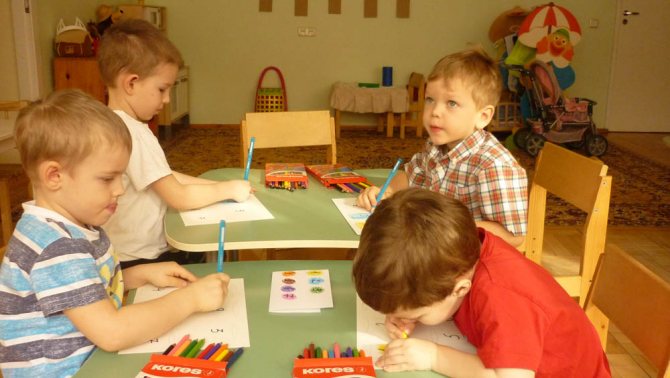
Mathematics at preschool educational institutions
Children's imaginative thinking is very developed at the age of 4-5 years, so this method is often used in preschool institutions. This method requires demo material:
- Pictures;
- cards;
- cartoons;
- toys;
- living material: leaves, shells, cones, fruits;
- slides and more.
Additional Information. There are many manuals and literature that can help parents and children learn, for example, authors such as E. Bortnikova, K. Shevelev, L. Peterson, E. Kolesnikova, L. Mavrina, etc. will help young mathematicians better understand the material.
The next method is practical. The only condition is that the child must complete the tasks independently. Thanks to this method, the child will be able to apply the acquired skills in the world around him.
GCD lesson on speech development in the middle group
Verbal methods - no one has canceled a simple explanation to a preschooler. All kinds of conversations, explanations, examples, as well as questions.
The game method is one of the frequently used teaching methods in kindergartens. It was already noted above that with the help of games it is easier for a child to master a difficult topic for him. But this method also forms creative thinking in the child and develops imagination. This can include games, both collective and individual, distribution of roles, imaginary plots, situations requiring one or another solution.
Note. Each of these methods cannot exist independently. They must intersect or flow from each other.
If we consider the frequency, then when conducting mathematics classes for children 4-5 years old, it is necessary to take into account that teachers recommend 10 lessons per week for 15-20 minutes. There is no need to overload the child.
Quantity
At this age, children should understand that many objects consist of separate or homogeneous objects. For example, an adult asks children to find among the many rabbits the same one as he has in his hand.
Next, exercises are offered in which children select and group objects according to certain characteristics, for example: “Put all the blue balls in a basket, small mushrooms in one box, and large ones in another.” By completing tasks, children understand that all objects can be combined according to a certain characteristic.
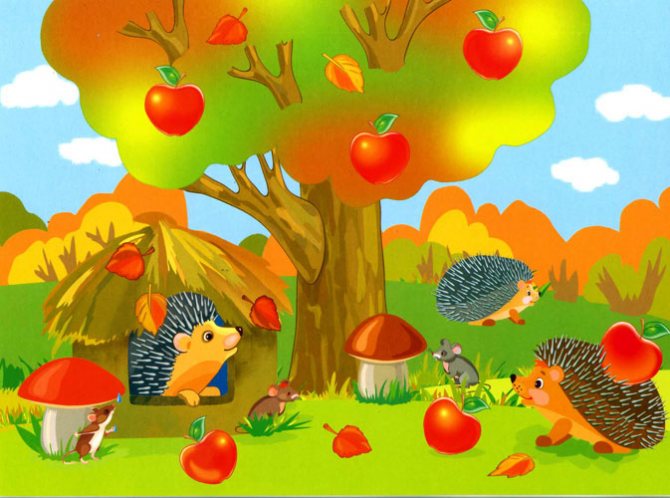
Learn the concept of quantity from a picture
In order to teach 3-year-old children to understand the words “one” and “many,” the following exercise is proposed: in accordance with the number of children, apples are placed on the table. The adult draws attention to the fact that there are a lot of apples on the table, after which he asks each child to take an apple. The kids see that each time there are fewer and fewer apples, and as a result, “a lot” disappears. The adult says that each child has one apple, but there is not a single one on the table. After the adult invites the children to put one apple back on the table, they get a lot of apples again.
By teaching children 3–4 years old to compare groups of objects, an adult introduces the concepts of “equality” and “inequality.”
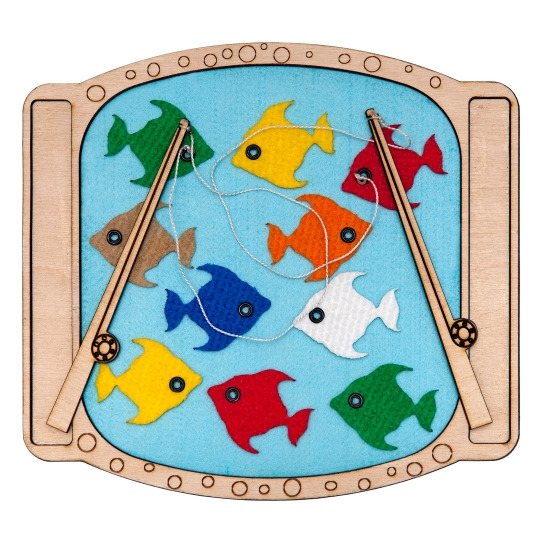
For this, the overlay technique is used. For example, the card shows 5 kittens. The adult offers to “put” each kitten in a basket, placing a picture with the image of a basket under each kitten. Then he draws attention to the fact that there are “as many” baskets as there are kittens, which means “equally”. By removing one picture of a basket, children understand that there are “more” kittens and “fewer” baskets.
What will help preschoolers learn mathematics?
Considering the methods of teaching mathematics to preschoolers, they help:
- children's games with a mathematical theme;
- demonstration tasks (how many apples are left in the basket);
- exercises in notebooks, etc.
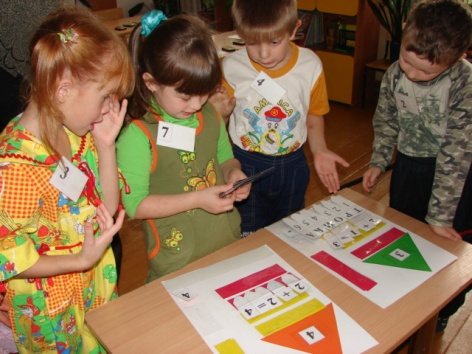
Game form
Some items have always been used and are working methods.
Math flashcards
One of the most common teaching materials is cards, in this case, math cards.
You can buy them, print them on a computer, or make them yourself from ordinary white cardboard, which is sold in any children's entertainment or stationery department, and depict numbers and the corresponding number of fruits, bears, and geometric shapes on them.
Note. Math cards will introduce preschoolers to the world of mathematics in an easy and relaxed manner and show what numbers look like.
Interactive games - simulators
Mathematics for children 4-5 years old involves a game-based learning method. It includes the use of interactive games - simulators. Will help develop:
- interest in mathematics;
- desire to play more games with mathematical content;
- attentiveness;
- logic.
Interactive games can be found in the form of special notebooks in office supply stores or as applications on your phone or computer online.
Children's finger gymnastics for kindergarten
Finger games
This didactic material is good because it is always at hand. You don’t need to invent anything, just sit down with your child and count. The purpose of such games is to teach the child to count using available materials.
Note. Alternating these methodological techniques during the learning process will have a positive effect on the desired result.
Educational games
There are many educational math games for 4-year-old children. For example,
- The game “Let’s Count” will help you learn to count. For this game you will need a ball, you need to throw it to the child and start counting from 1 to 10 and in reverse order.
- Develop the ability to navigate the arrangement of objects. Game "Where is the ball"? You need to put the child in the center of the room and put a ball in front of him. Ask him where he is now, change the location of the ball as answers come in.
- Be able to compare what is greater, less or equal. Game "Buttons". Take 10 buttons and divide them between you and your baby. Count them together (next time the child will count independently) and ask who has more, less or equal.
- Know the meaning of the words: high - low, wide - narrow. Cut out 4 bear cubs, bunnies or mice from paper or cardboard in advance. But so that the first one is taller than everyone else, the second one is shorter than everyone else, the third one is wider, the fourth one is narrower. Show the child by asking questions which one is which.
Features of age
Mathematics is not only arithmetic. This is also geometry and logic.
The methodological manuals describe the amount of knowledge easily achieved by a four-year student:
- ability to count to 5, answer the question “How many?”;
- compare groups of objects using counting; know the concepts of “many”, “few”, “equally”;
- compare objects of different lengths, widths, heights, understand the relationships between them;
- recognize and name circle, square, triangle, rectangle;
- determine the direction of movement from yourself (right, left, forward, up, down);
- know your right and left hands.
In my favorite book, “Leaping Mathematics,” which I referred to and which is a reference book for me, more skills are listed. And they are divided into 2 categories: group interaction and study skills. I will not rewrite them here; if you need them, read them in the source.
Our “mathematical” luggage by the age of 4
Free count to twenty. Then my daughter counted according to the learned principle, but got confused in the tens. She could say “twenty ten” (this quickly passed after 4 years, when one day I suggested she count in tens - she quickly remembered tens up to 100).
The numbers were mastered visually, but she did not write them herself (she started writing them at about 4 years 2 months - she “grew up”, she herself showed interest).
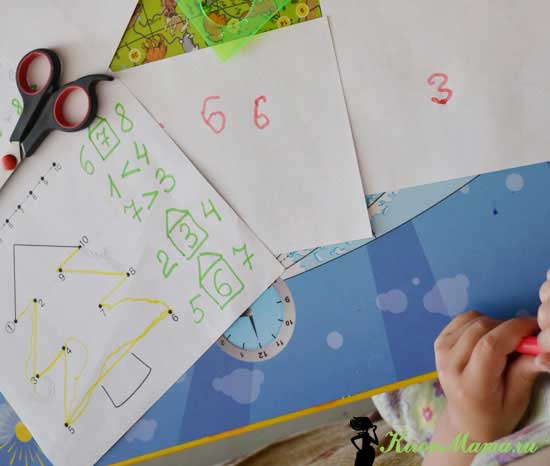
In addition to flat figures, my daughter knew several three-dimensional ones (cube, octahedron, pyramid and some others). I didn’t plan to give this knowledge, but she became interested in the game Monument Valley on the tablet, and her natural interest arose from the plot of this game (at the end of each level the heroine girl takes out a figure from a cap). To answer the questions, I had to refresh the information about them.
At the age of 4, Dasha really loved puzzles - simple problems involving addition and subtraction within five. These problems appeared spontaneously (like most activities), but she liked them so much that she asked for more and more. On the very first day, she understood the principle and composed her first problem for me (I think it’s very good when a child can not only solve, but also compose problems).
Didactic material in the study of elementary mathematics
Didactic material is a type of visual teaching aid, cards, tables, graphs, stands, coloring books, notebooks, plants, animals. You can cook them yourself or buy them in stores, but the goal remains the same:
- teaching numeracy and literacy;
- development of fine motor skills and tactile sensitivity;
- relieving emotional stress;
- development of memory, thinking, attention;
- speech development.
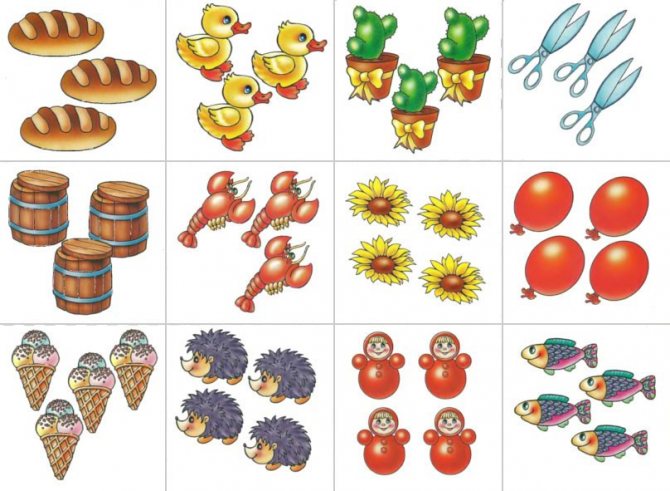
Math flashcards
Mathematics for children 4-5 years old will be much more effective and interesting if you use didactic material.
Mathematics for preschoolers 4-5 years old is a completely new entertaining world. The material will help you figure out where to start and what to pay attention to. Using what you have read above, love and a little patience, you can achieve the results necessary for your child.
Print jobs
In addition to purchased teaching aids, from time to time I slip in assignments downloaded from the Internet and printed on a printer. Our printer is black and white, but it is quite enough. Printable tasks can be found for every taste and color. These include labyrinths, logical chains, graphic dictations, connecting dots by numbers, and so on, so on, so on.
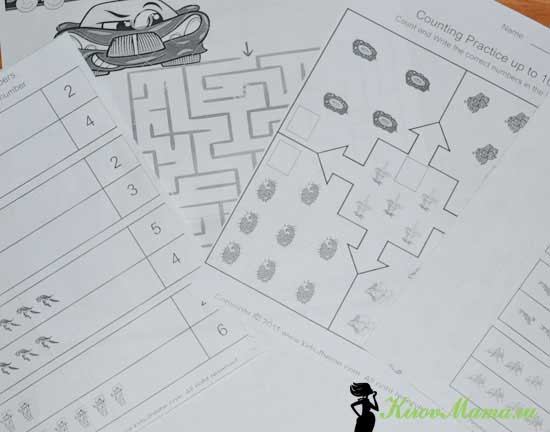
In the meantime, for the first lessons you can print out pages from test tasks for a 4-year-old child concerning mathematics (from 2nd to 10th).
